What is Vibe Testing?
|
|
Testing is more than just test automation. In vibe coding, AI creates lines of code based on prompts, but there’s no guarantee that this code is suitable to be shipped out. You need a way to test not just the code, but also if the code matches the user’s “vibe”. After all, just because AI created something, it doesn’t mean it is perfect. It’s the user who decides this. This brings us to vibe testing. The involvement of AI is another reason that makes vibe testing so appealing to testers because it acts as an intelligent assistant that constantly learns and gets better.
“The global AI-enabled testing market size was valued at USD 856.7 million in 2024 and is projected to grow from USD 1,010.9 million in 2025 to USD 3,824.0 million by 2032.”
These numbers show just how popular AI is becoming in the QA realm. If testers want to keep up with modern QA practices, then understanding vibe testing is a must.
This guide will help you with just that.
| Key Takeaways: |
|---|
|
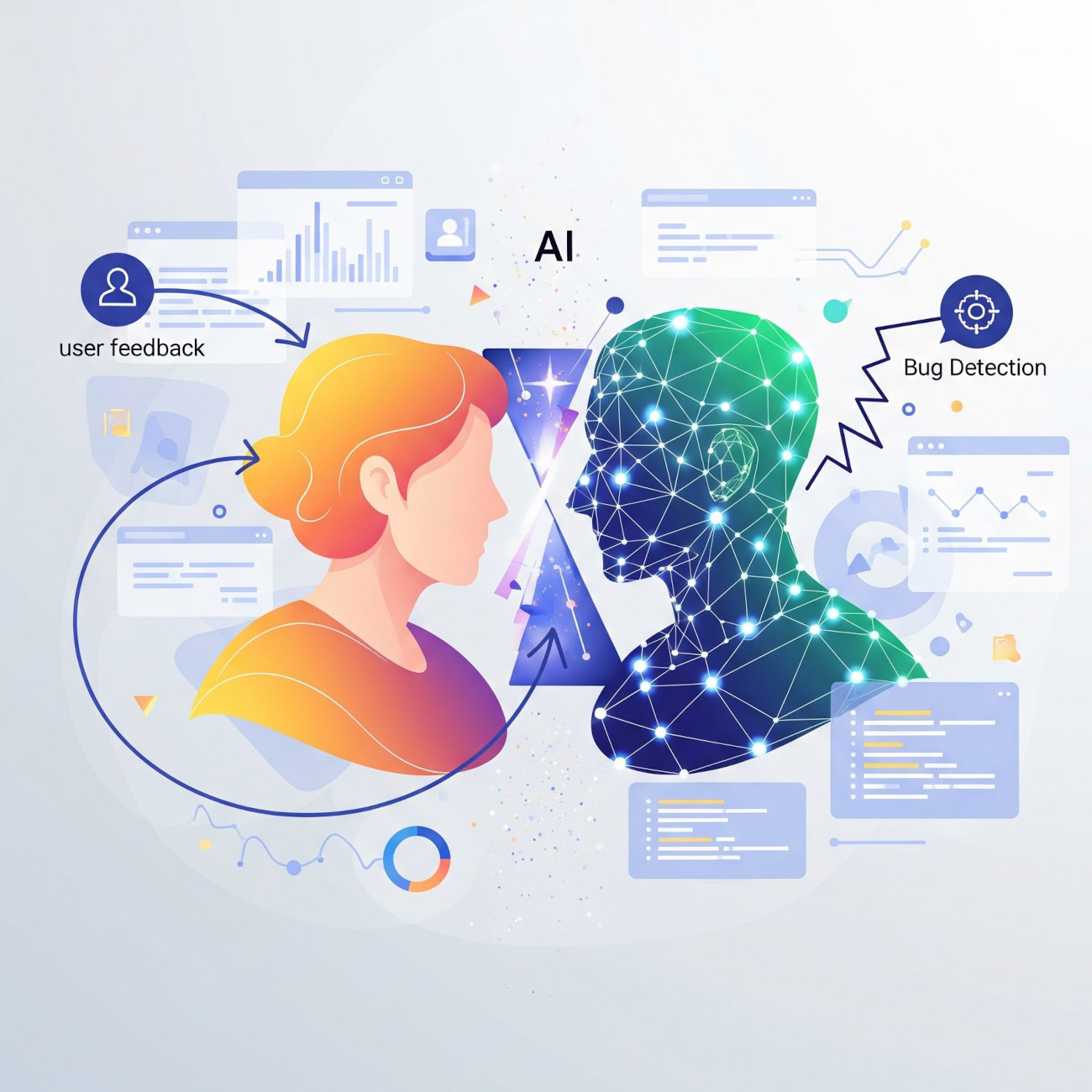
What is Vibe Testing?
Just as “vibe coding” shifts the focus from writing every line of code to guiding creation with intent, “vibe testing” represents a similar evolution in how we ensure software quality. Instead of meticulously checking off every single, predetermined test case, vibe testing is about verifying that the software delivers the intended experience – that it truly “feels” right, meets the unspoken expectations of the user, and aligns with the overall “vibe” the creators aimed for.
It checks the interface’s intuitiveness and the user’s experience with the application.
Vibe testing goes beyond simple functional checks (like “does this button work?”) to assess the overall “feel” of the software. It looks for subtle problems that a human might notice, like a jarring animation, a confusing flow between screens, or an inconsistent design, that traditional automated tests would miss.
It uses AI to do testing.
Just as vibe coding uses AI to generate code from natural language prompts, vibe testing uses AI to generate tests and evaluate the software from a user’s perspective. The AI can act as a “smart assistant” for testers, helping them create tests based on their goals and intuition rather than manually writing every line of code.
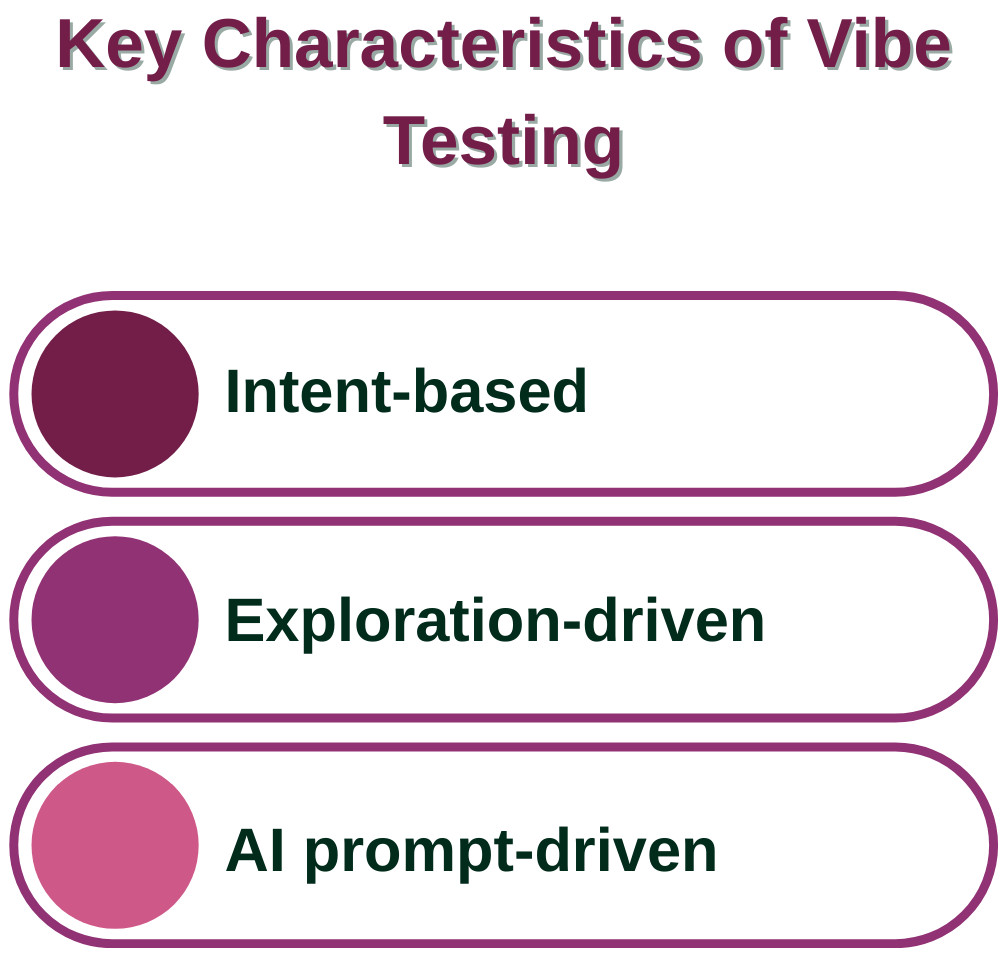
While the term “vibe testing” may be trending now, the practice of checking from a user’s perspective has been around for a while. Earlier, it would be done manually through user feedback, surveys, internal walkthrough, exploratory testing, or even methods like canary testing or A/B testing. But with AI, the process is evolving into something better.
AI can be trained to catch issues that are invisible to traditional automated testing. These could include issues like those of user experience (UX) and UI. Moreover, it can learn from past data (like bugs and test reports) and prioritize those areas. It thus gives the feeling of having a tireless assistant who can test with the user in mind.
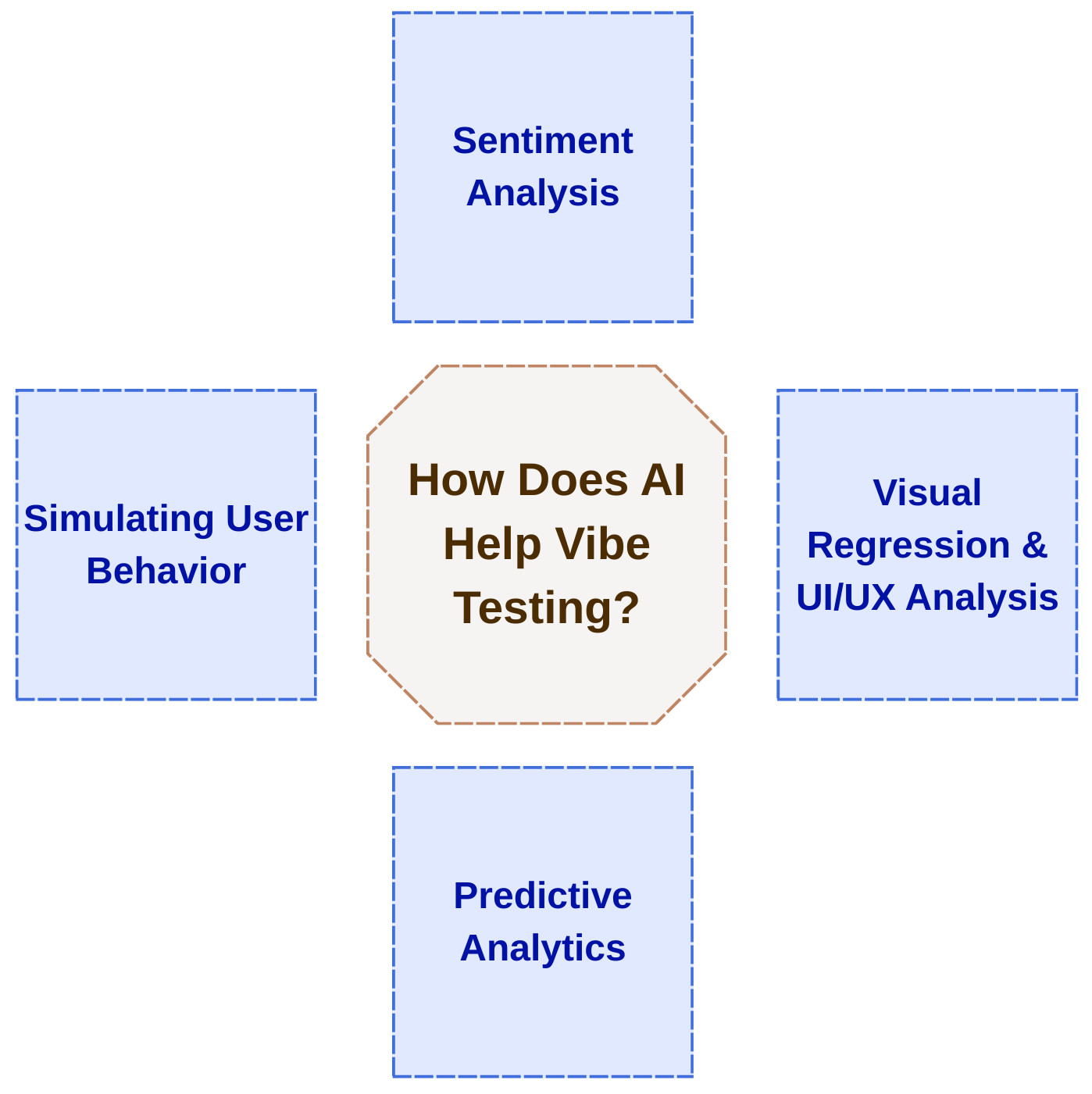
How Does Vibe Testing Work?
In a vibe testing scenario, the quality assurance (QA) process becomes less about coding test steps and manual checklists and more about intelligent evaluation.
- Defining the “Vibe”: The first step is to articulate what the desired “vibe” or user experience is. You’re giving your AI testing assistant a sense of what needs to be tested.
- AI Generates and Executes Tests: This is where the heavy lifting happens. Your AI testing assistant doesn’t just run a pre-written script. Instead, it:
- Creates Diverse Scenarios: Based on your “vibe” description and the underlying code, the AI can intelligently generate a wide array of test scenarios. It explores possibilities a human might not immediately think of.
- Simulates User Behavior: The AI can then simulate real user interactions – clicking buttons, typing in forms, swiping through pages, even trying to “break” the system in unexpected ways, all at incredibly high speeds.
- AI Identifies “Vibe” Deviations: If the AI detects something that clashes with the defined “vibe” – perhaps a slight delay in a page load that makes it feel clunky, an inconsistent font size that makes it look unprofessional, or a sudden crash that certainly doesn’t feel “secure” – it flags it. It might highlight specific pieces of code, log the exact user actions that led to the issue, or even suggest why it believes the “vibe” is off.
- Human Oversight and Refinement: While the AI does a lot, human testers remain essential. They review the AI’s findings, validate critical issues, and, most importantly, refine the AI’s understanding of “vibe.” If the AI consistently flags something as “off” that you deem acceptable, you can “teach” it to adjust its perception. This collaboration helps the AI get better at understanding subtle nuances of user experience.
Why Vibe Testing Matters?
Vibe testing goes beyond standard checks to make sure your app is not only functional but also intuitive and enjoyable. Here’s why it’s a crucial next step for your business:
- Focuses on the User Experience: Vibe testing ensures your product has a smooth, logical flow that just feels right to the user. While traditional testing checks if a button works, vibe testing assesses if that button is in the right place and if the transition to the next screen is smooth and intuitive.
- Catches Subtle Problems Early: It helps you find subtle issues that a normal person would notice, but a standard checklist test would miss. It could be a slightly confusing menu, a slow transition between screens, or a button that looks out of place.
- Creates a Stronger Brand: Today, a polished and enjoyable user experience is a major selling point. Apps that are intuitive and feel refined stand out from the rest. Vibe testing helps you achieve that high level of quality, leading to happier customers, better reviews, and a stronger brand reputation.
- Provides a Competitive Edge: Many companies are still focused on basic, functional testing. By adopting vibe testing, you are embracing a forward-thinking approach that puts the user at the center of the development process. This gives you a significant advantage by creating products that are not only functional but also a joy to use.
Examples of Vibe Testing in Action
- UI/UX Consistency: AI might be tasked with ensuring that all buttons across an application have the same hover effect, click feedback, and response time, providing a consistent “vibe” of professionalism.
- Performance Beyond Numbers: Instead of just checking if a page loads within 2 seconds, an AI could evaluate if the loading animation feels smooth, if content appears gracefully, and if the user perceives the experience as “fast,” even if the raw numbers are slightly slower than a different but less intuitive loading method. Read: What is Performance Testing: Types and Examples.
- Detecting Subtle Bugs: An AI might notice a tiny graphical glitch that only appears when a user performs a very specific, rapid sequence of actions – something a human might miss in routine testing, but which breaks the “polished” vibe.
- Automated User Acceptance Testing: Imagine describing your desired “user journey” (“User logs in, adds item to cart, proceeds to checkout, and completes purchase successfully with a feeling of confidence”). An AI could then simulate this journey, not just checking for functionality, but also evaluating whether the feeling of confidence or ease was maintained throughout. Read: User Acceptance Testing: Manual vs. Automated Approaches.
Tools for Vibe Testing
How do you test something that you didn’t write the code for? You may still need some knowledge of the underlying code in traditional test automation. Luckily, you need not worry about all these implementation details to make vibe testing possible. With a generative AI-powered no-code tool like testRigor, you can leave it to AI to do the heavy lifting for you.
Build Test Cases Based on the “Vibe”
testRigor lets you build test suites and test cases based on plain English descriptions of the scenario and app involved. Here are some of the ways in which testRigor lets you capture the vibe.
-
Gen AI-based Test Suite Creation: When creating a test suite, describe the app you want testRigor to build test cases for and choose the number of test cases testRigor should create for you.
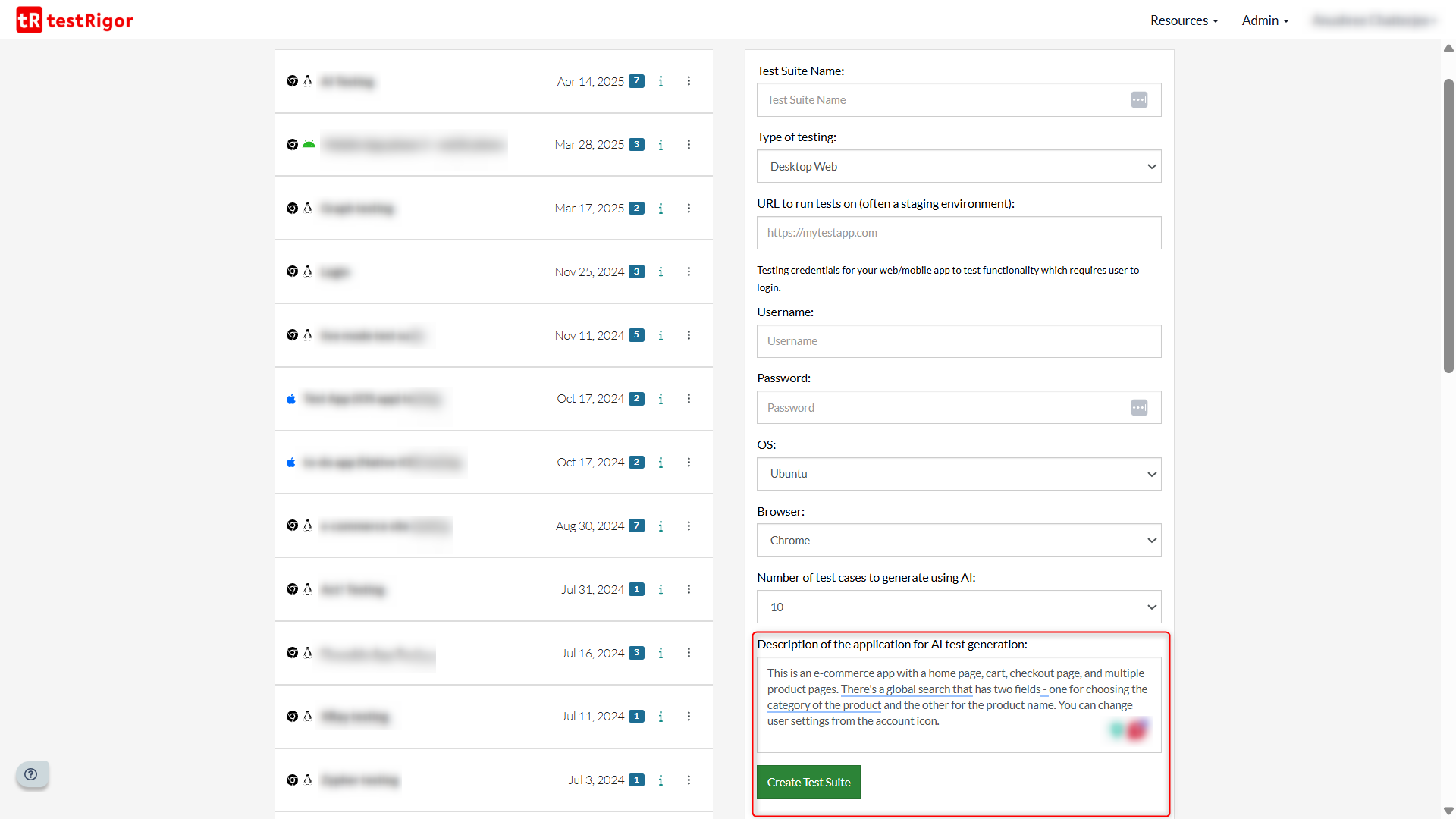
-
Gen AI-based Test Case Creation: Within your test suite, you can create test cases using gen AI easily. Provide context to testRigor about the scenario you want it to test, and watch it create a full-fledged test case for you in plain English.
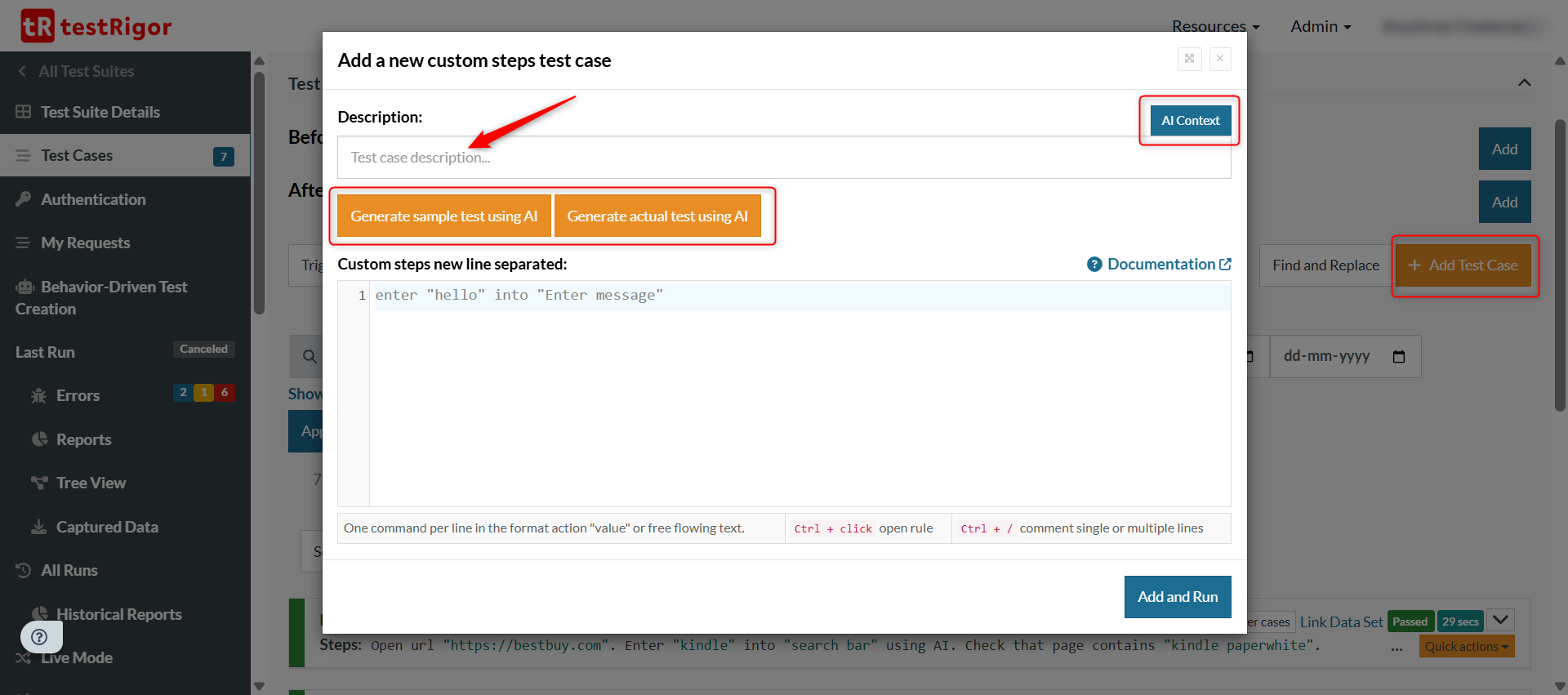 You can provide further AI context to describe how the application under test looks through the “AI Context” section.This will help the AI engine get a better understanding of what it is working with, which in turn will give you more accurate test cases.
You can provide further AI context to describe how the application under test looks through the “AI Context” section.This will help the AI engine get a better understanding of what it is working with, which in turn will give you more accurate test cases.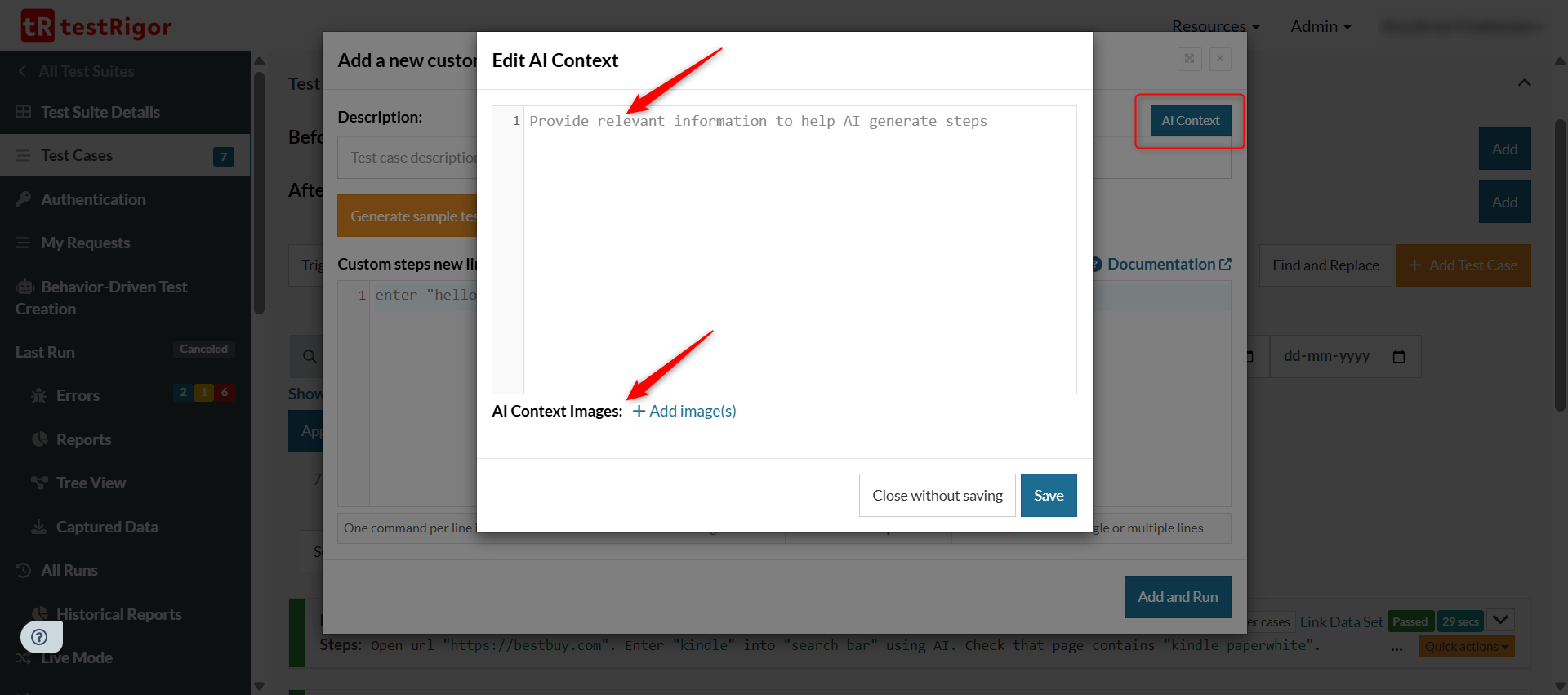 Here are more ways in which testRigor lets you capture the vibe through its easy test creation process – All-Inclusive Guide to Test Case Creation in testRigor.
Here are more ways in which testRigor lets you capture the vibe through its easy test creation process – All-Inclusive Guide to Test Case Creation in testRigor.
Let AI Check the Vibe when Testing the Untestable
Vibes cannot match unless the system can pick up on the human intent. With testRigor, you can make AI do a lot, like visually validate diagrams like graphs, check the sentiment of content, verify LLMs, and more. testRigor’s AI vision lets it interact with the UI as a human would to visually identify elements and interact with them. This gives testRigor an upper hand compared to its contemporaries, who might limit visual testing to just comparing screenshots.
Figure out What’s Happening at Every Step
testRigor gives you a very thorough view of test executions.
-
Get detailed step-wise results with run logs
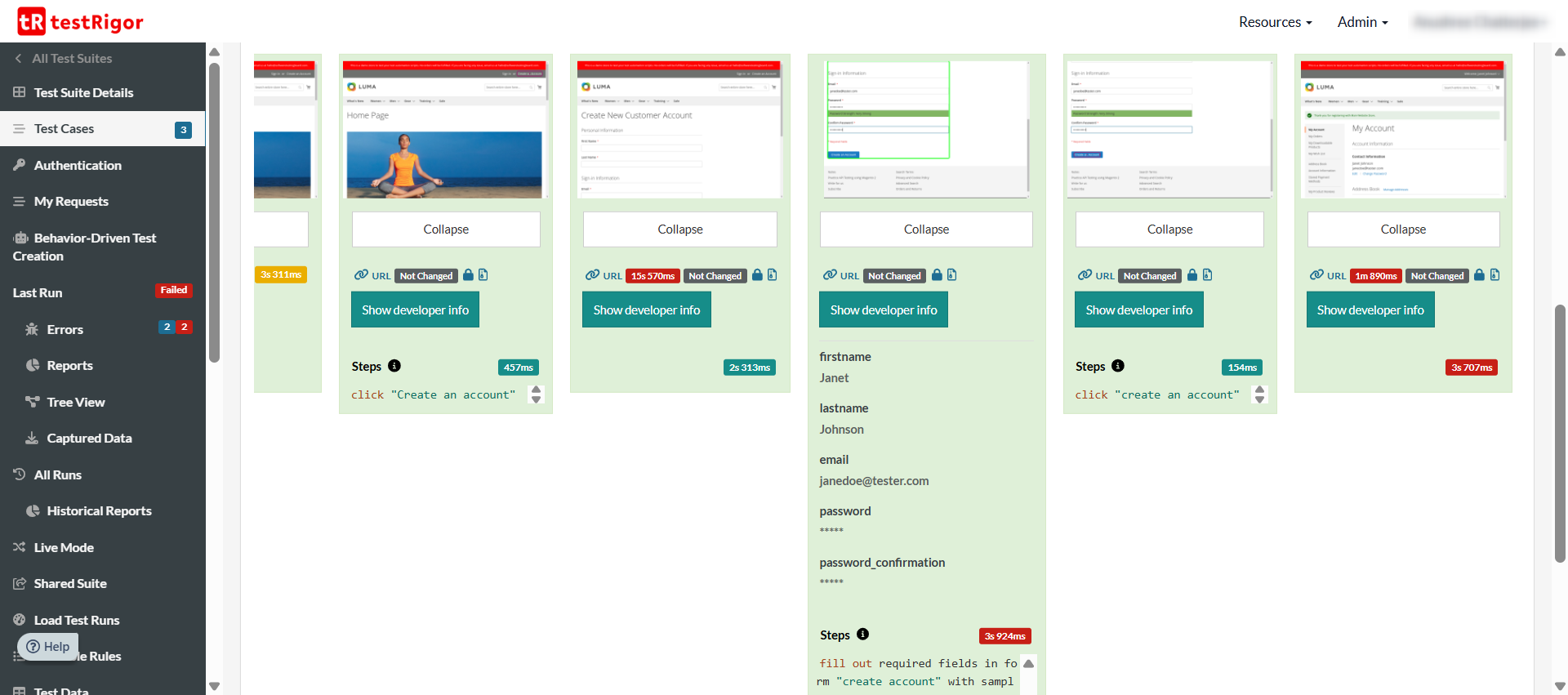
- Video captures of what was executed
-
Detailed reports of errors and executions
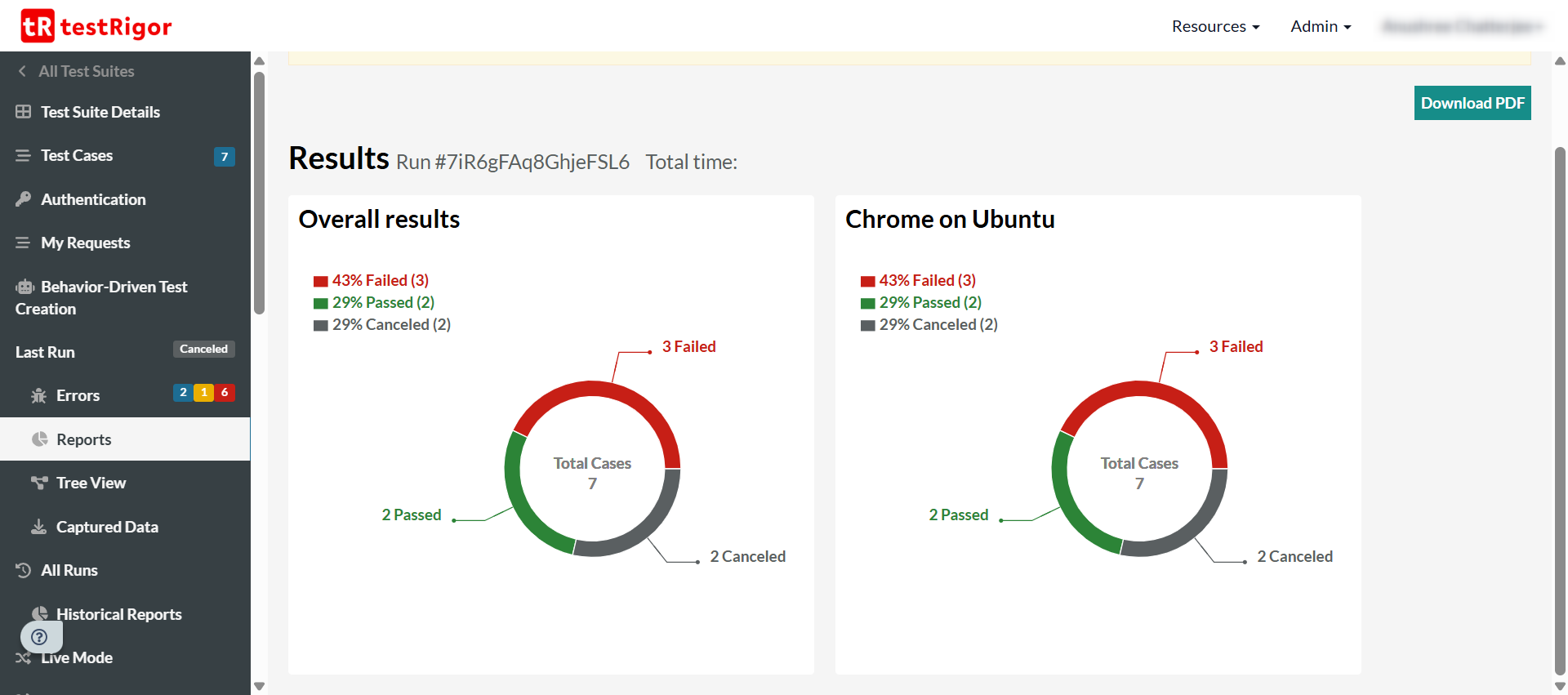
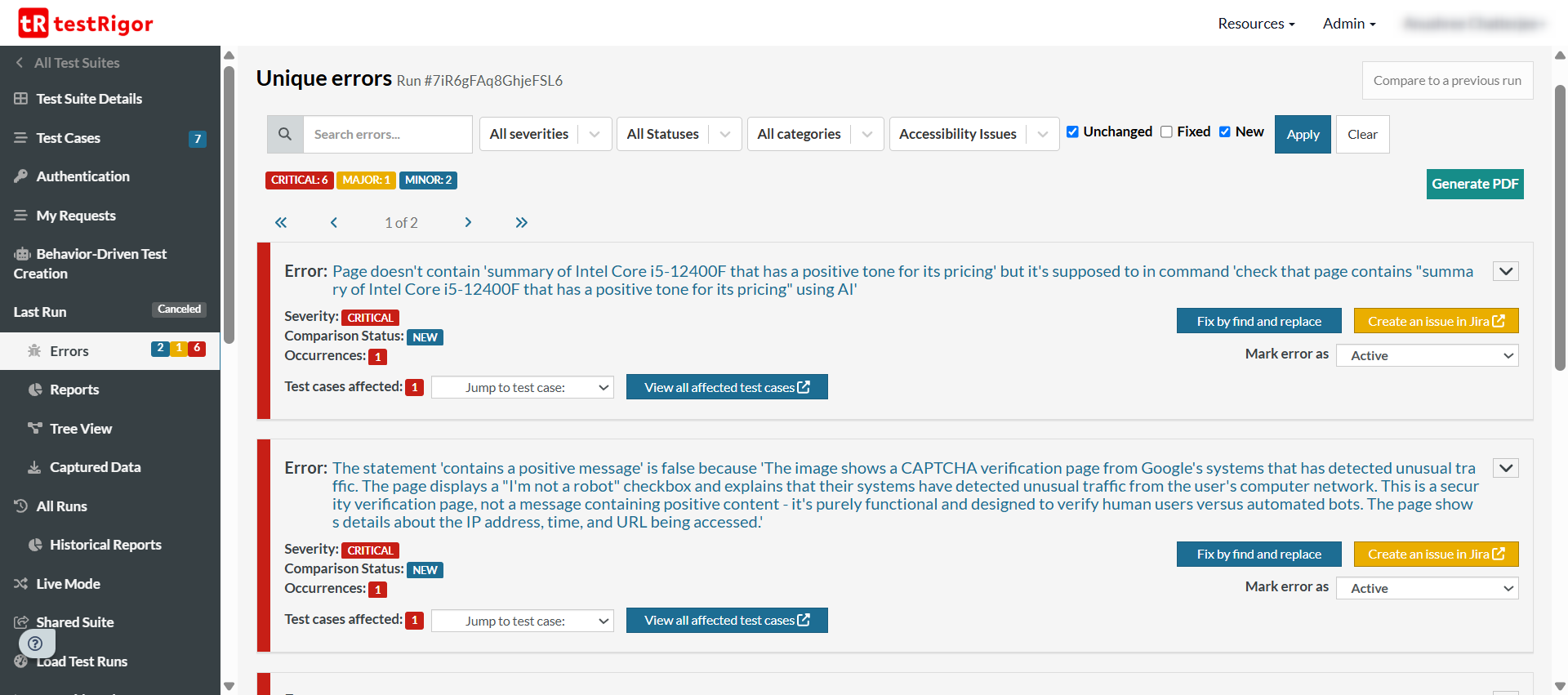
Say Goodbye to Test Maintenance Headaches Due to Evolving Application
testRigor acts as a human emulator, meaning that it perceives elements on the UI visually rather than by their position in the code (through XPaths and CSS selectors). Even if the underlying code changes cause the UI elements to move around, have a different appearance, or even have slightly different text, testRigor can identify these changes. Tests that would otherwise fail in traditional test automation carry on smoothly thanks to testRigor’s ability to fix tests in broken UIs, ensuring that the focus remains on testing the vibe rather than the code. Read: AI-Based Self-Healing for Test Automation.
The sky is the limit for you! Take a look at what more you can do with an intelligent tool like testRigor over here.
Vibe Testing vs. Traditional Automated Testing
The two testing methods have very different goals and approaches. Traditional automated testing focuses on repeatable, scripted checks to ensure things work as planned, while vibe testing is about using smart tools to evaluate the overall feel and user experience of your app.
Here’s a breakdown of the key differences:
| Feature | Vibe Testing | Traditional Automated Testing |
|---|---|---|
| Main Goal | To check the software’s overall feel, intuitiveness, and user experience. | To check if the software functions correctly according to predefined rules. |
| How it Works | Uses AI-powered tools that can learn and explore the app like a human user would, looking for subtle issues. | Uses manually scripted instructions that a machine follows step-by-step. |
| What it Catches | Catches intangible issues related to user frustration, such as a confusing menu flow, an awkward design, or a bad “vibe”. | Catches specific, quantifiable issues, like a broken button, a page that fails to load, or incorrect data. |
| Best For… | Evaluating a product’s quality from a user’s perspective and finding problems that don’t have a clear “bug report”. | Repetitive checks like regression testing (making sure new changes haven’t broken old features) and a large number of simple, well-defined tests. |
| Strengths | Finds issues that are hard to describe, provides a deeper understanding of the user journey, and adapts to changes in the app’s design. | Fast, consistent, and reliable for checking known functionality. Great for a checklist of required features. |
| Human Role | Testers guide the AI and analyze its findings, focusing on higher-level quality and user insights. | Testers spend a lot of time writing and maintaining scripts for the machine to follow. |
Conclusion
Vibe testing involves AI, taking user-centric testing to a whole new level. By focusing on the user’s “vibe”, you’re not just fixing bugs; you’re building a better product and a stronger brand. Good tools can help you make the most of this practice.
| Achieve More Than 90% Test Automation | |
| Step by Step Walkthroughs and Help | |
| 14 Day Free Trial, Cancel Anytime |












